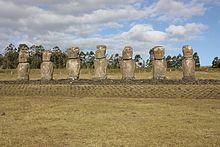Ahu Akivi

At Ahu Akivi, the moai face the ocean. Although the platform is clearly visible, the overgrown grass obscures the pattern of the sloping pavement.
|
|
| Coordinates | 27°6′54″S 109°23′42″W / 27.11500°S 109.39500°WCoordinates: 27°6′54″S 109°23′42″W / 27.11500°S 109.39500°W |
|---|---|
| Location | Easter Island |
| Designer | Rapanui people |
| Type | Sacred stone statues |
| Material | Volcanic rock |
| Length | 70m |
| Height | 16 ft |
| Beginning date | Originally 15th century |
| Completion date | Restored in 1960 |
| Dedicated to | Make Make worship |
Ahu Akivi is a particular sacred place in Rapa Nui (or Easter Island) in the Valparaíso Region of Chile, looking out towards the Pacific Ocean. The site has seven moai, all of equal shape and size, and is also known as a celestial observatory that was set up around the 16th century. The site is located inland, rather than along the coast. Moai statues were considered by the early people of Rapa Nui as their ancestors or Tupuna that were believed to be the reincarnation of important kings or leaders of their clans. The Moais were erected to protect and bring posperity to their clan and village.
A particular feature of the seven identical moai statues is that they exactly face sunset during the Spring Equinox and have their backs to the sunrise during the Autumn Equinox. Such an astronomically precise feature is seen only at this location on the island.
Ahu Akivi, aligned in an east–west direction, is located on the flank of the southern slope of Maunga Terevaka at Rapauni and it is surrounded by fairly flat agricultural land. It is 2.3 kilometres (1.4 mi) inland in the non coastal zone and is at an elevation of 140 metres (460 ft). Ahu Vai Teka is at a distance of 706.8 metres (2,319 ft) from Ahu Kavi which is considered as part of the Ahu Akivi-Ahu Kavi complex.
From Hanga Roa, an inland road leads to the site via the volcanic cone of Terevaka (510 metres (1,670 ft) peak level). The coast road is via Playa Anakena. On this road there are many moi statues lying scattered and un restored. There are paths branching off to Puna Pau, which is a quarry of low volcanic crater with red coloured rocks known as scoria, which has been used to carve 70 of the "top hat" of the statues known as pukao which could be cylindrical top knot of hair or grass hat or turban. Further on, the site of Ahu Akivi is reached. The site is located to the Northeast of Hanga Roa, the capital city of Easter Island, about 10 kilometres (6.2 mi) to its north.
The Rano Raraku quarry from where the statues were made is at least 15 kilometres (9.3 mi) away and free access is through the land route held by the clans.
...
Wikipedia
